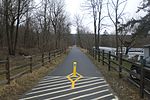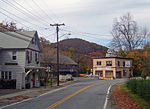Hendrik Winegar House
Dutchess County, New York Registered Historic Place stubsHouses completed in 1761Houses in Dutchess County, New YorkHouses on the National Register of Historic Places in New York (state)National Register of Historic Places in Dutchess County, New York
Hendrik Winegar House was a historic home located at Amenia in Dutchess County, New York. The structure was demolished after decades of neglect. It was a 2+1⁄2-story, rectangular house on a high basement built of thick fieldstone and brick walls, built about 1761. It had a steeply pitched gable roof. It was coated in stucco applied about 1850.It was added to the National Register of Historic Places in 1975.
Excerpt from the Wikipedia article Hendrik Winegar House (License: CC BY-SA 3.0, Authors).Hendrik Winegar House
Leedsville Road,
Geographical coordinates (GPS) Address Nearby Places Show on map
Geographical coordinates (GPS)
| Latitude | Longitude |
|---|---|
| N 41.827777777778 ° | E -73.511388888889 ° |
Address
Leedsville Road 80
12561
New York, United States
Open on Google Maps








